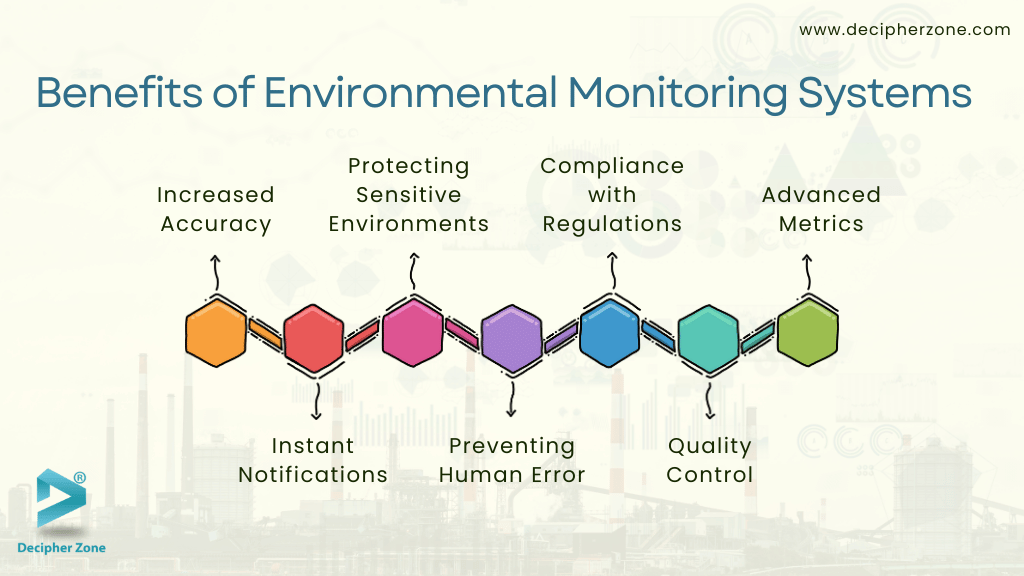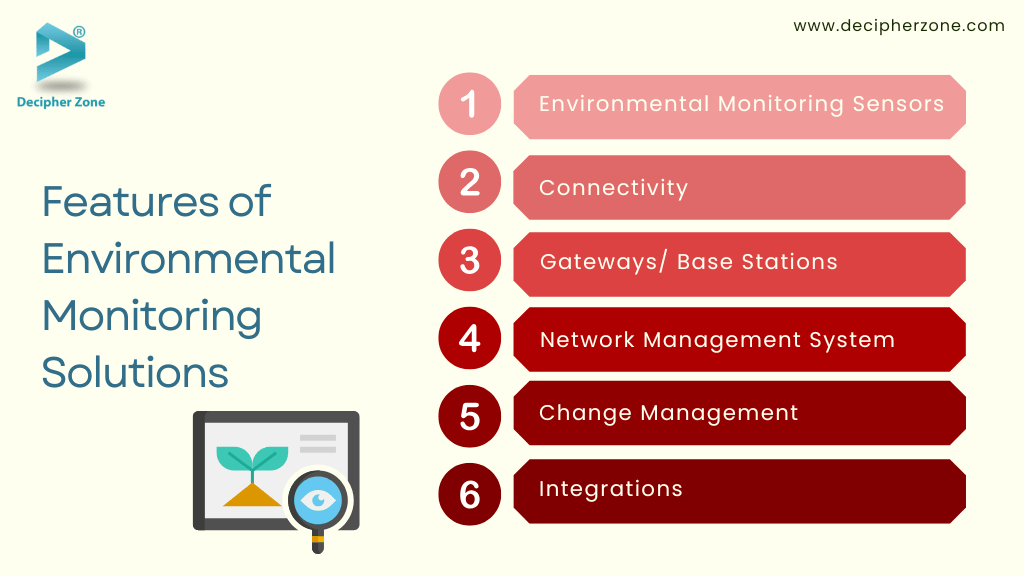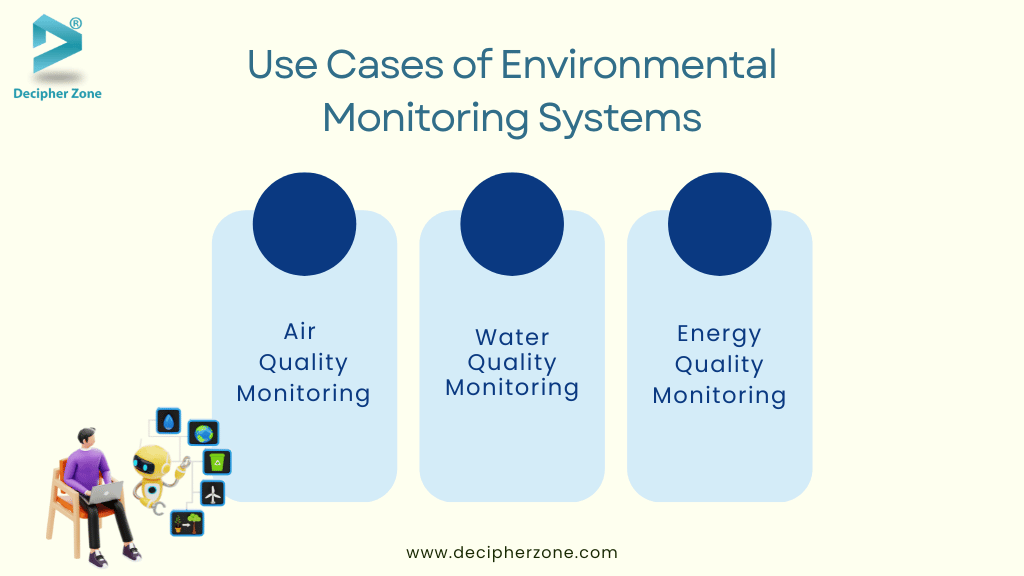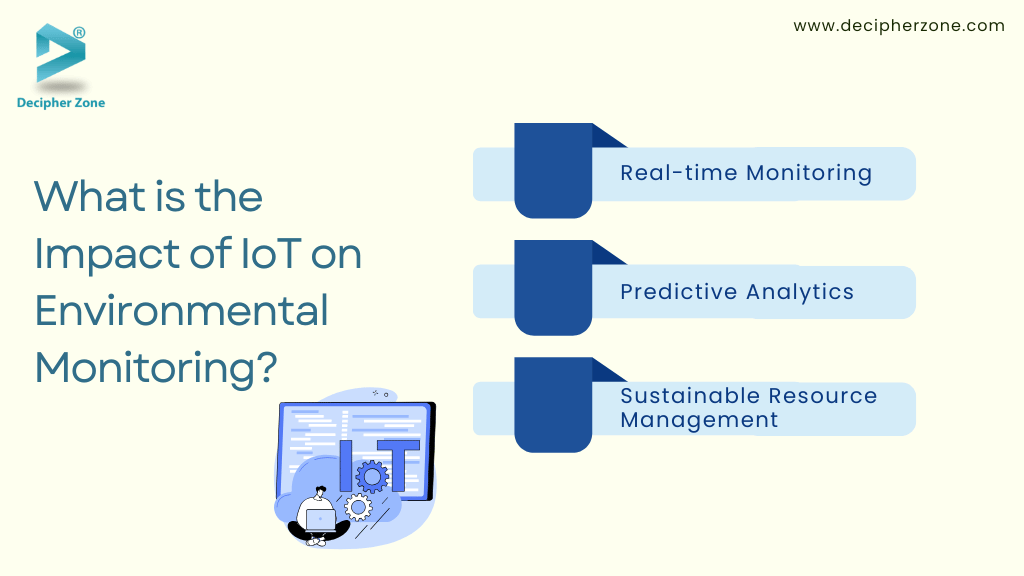Increasing contamination levels, unexpected climate change, etc—watching such environmental conditions requires transforming environmental monitoring software. But how exactly does IoT transform environmental monitoring? And why is this technology becoming a game-changer in sustainability and disaster prevention? Let’s explore the key benefits and types of IoT-driven monitoring solutions and how they are paving the way for a smarter, greener future.
The environment is changing at an alarming rate, and we can see the effects—rising pollution levels, unpredictable climate shifts, deforestation, and resource depletion. To combat these challenges, environmental monitoring has become a necessity, helping businesses, governments, and communities track and respond to environmental threats in real-time.
But here’s the problem: traditional monitoring methods are slow, labor-intensive, and often inaccurate. By the time an issue is detected—whether it’s toxic gas leakage, unsafe air quality, or excessive industrial emissions, it may already be too late. This is where the Internet of Things (IoT) is transforming environmental monitoring systems.
Imagine a forest equipped with smart IoT sensors that can spot early signs of wildfires, automatically notifying emergency services before the flames have a chance to spread.
Or consider a city using IoT-powered air quality sensors to track pollution levels and adjust traffic patterns to cut down emissions. These aren’t just futuristic ideas but real-world applications of IoT that are already shaping a more sustainable world.
So, if you are interested in shaping futuristic, bold ideas into reality, make sure to stick around until the end of the blog! Your insights could play a crucial role in shaping the future with us. Let’s dive in!
Understanding Environmental Monitoring Systems Software
Environmental monitoring systems act as guardians that closely assess the air, soil, and water to evaluate their current conditions, identify trends and changes, forecast potential issues, and offer early risk earrings.
These systems play a crucial role in helping policymakers make well-informed decisions to safeguard natural resources and implement effective conservation strategies.
At the heart of these systems lies environmental monitoring software, which is a powerful tool that enhances their efficiency, accuracy, and responsiveness. By collecting, analyzing, and visualizing real-time data from various sensors, this software allows businesses to monitor environment changes, detect anomalies, and take proactive measures to mitigate risks.
Modern environmental monitoring software integrates with IoT data loggers and remote sensors to automate data collection and provide instant alerts. It employs predictive analytics, allowing industries, researchers, and government to track trends and address environmental risks effectively, ensuring compliance and sustainability.
With advancements in cloud computing and AI, this software offers real-time reporting and remote access via web and mobile applications, providing decision-makers with actionable insights to promote a sustainable and resilient future.
Why Invest in Environmental Monitoring Systems
The need for proactive monitoring and data-driven decision-making has never been greater. Environmental monitoring systems leverage advanced sensors and IoT-driven technology to track environmental parameters in real time, detect anomalies, and provide early warnings before disasters strike.
According to global reports, 2023 was the warmest year on record, triggering devastating wildfires, floods, and storms, with billions in economic losses. These disasters highlight the urgency of sustainable practices and early detection systems to mitigate their impact.
Investing in environmental monitoring systems opens up a world of possibilities for organizations. Here’s how
-
Detect anomalies before they escalate into major environmental disasters.
-
With accurate, real-time data at your fingertips, navigating requirements becomes a breeze.
-
Optimize energy and resource use, making every action count towards a greener future.
-
Utilize AI-powered analytics and predictive modeling to make informed, strategic choices.
-
Keep a close eye on pollutants and climate trends, safeguarding ecosystems and public health for generations to come.
7 Benefits of Environmental Monitoring Systems
Implementing environmental monitoring systems can provide real-time, automated tracking of environmental conditions, ensuring accuracy, efficiency, and proactive decision-making. Here are the key benefits:
1. Increased Accuracy
Businesses can track environmental conditions at frequent intervals, gaining granular insights that manual checks cannot provide with real-time monitoring. This helps in detecting trends, making informed decisions, and optimizing processes based on a holistic view of environmental changes.

2. Instant Notifications
Automation in environmental monitoring software provides real-time notifications when conditions exceed set thresholds, allowing immediate corrective actions before problems escalate. This is crucial for preventing damage, equipment failure, and environmental hazards.
3. Protecting Sensitive Environments
Sometimes, it can be hard to receive information from within an environment without stepping into it or otherwise disrupting it. Wireless monitoring allows data collection without human interference, preserving delicate ecosystems, research environments, or controlled spaces without disturbance from physical presence.
4. Preventing Human Error
Automation eliminates risks associated with manual data typos, omissions, accidental errors, malicious data entry, and delays in receiving information data, ensuring more reliable and accurate environmental data for decision-making.
5. Compliance with Regulations
Many industries with strict environmental regulations benefit from automated monitoring software, ensuring compliance with real-time tracking, historical data logs, and automated reporting. This simplifies audits and regulatory adherence, reducing risks of penalties or invalidated results.
6. Quality Control
Continuous monitoring ensures optimal conditions, reducing spoilage, waste, and financial losses. Environmental stability is critical for product consistency and quality assurance in industries like manufacturing, food storage, and pharmaceuticals.
7. Advanced Metrics
By leveraging AI and machine learning, environmental data can be used to,
-
Predict future trends for future planning
-
Optimize the environment and other operation
-
Discovering the hidden relationship between environmental factors
Features of Environmental Monitoring Solutions
This section will take you to a deeper understanding of how IoT-enabled environmental monitoring solution features, let’s explore its key components and how they contribute to the effectiveness of management and evaluation of different types of data.
1. Environmental Monitoring Sensors
The adoption of environmental monitoring sensors helps enhance operational efficiency while significantly cutting costs by optimizing energy usage and reducing waste.
The choice of sensors is determined by the specific environmental traits to be monitored and the goals at hand. For example, sensors utilized in a forest fire prevention system will be different from those employed to track water levels and prevent flooding in rivers and streams.

2. Connectivity
Although not a tangible component, connectivity is a key element enabling sensors to transmit the data they collect in the field. Environmental monitoring software often covers sparsely populated areas that may have limited or unreliable coverage.
This makes Low Power Wide Area Network (LPWAN) technologies an ideal choice for communication. These technologies offer a dependable and energy-efficient infrastructure, allowing sensors and devices situated in remote environmental locations to send data over long distances.
3. Gateways/ Base Stations
These devices are designed to withstand environmental conditions, including temperature variations, humidity, and exposure to the elements, which depend on the development location. This feature allows them to deliberately place them to cover broad geographical areas and be managed remotely.
4. Network Management System
Network management system manages communication and operation of large infrastructures. It receives the environmental data packets generated by the sensor nodes and relies on gateways.
This system handles essential tasks such as decryption, authentication, and routing. While also optimizing network resources. It minimizes latency and ensures that high levels of security and reliability are maintained throughout the process.
5. Change Management
Change management allows data center monitoring systems to watch if they may have an influence on network performance and monitor infrastructure additions and configuration changes. DCIM (data center infrastructure management) software packages are also a useful tool for this type of capacity planning, asset tracking, and management.
6. Integrations
The utilization of a data center monitoring system often indicates the usage of various business-grade IT solutions. It is important to select an IoT monitoring system that can seamlessly integrate with a diverse array of technologies.
Integration with modeling tools, asset management tools, change management tools, and other third-party solutions can facilitate the management of a wide range of challenges more effectively.
Other features are:
-
Real-time Data Display- Constant updates on air, water, and soil quality in comprehensive format (graphs, charts).
-
Geospatial Integration- Integration with maps to track environmental conditions in various places.
-
Predictive Analytics- Using historical statistics to forecast future environmental trends and conditions.
-
Open Access- Public access to dashboards for government agencies, businesses, and the public.
What is the Impact of IoT on Environmental Monitoring?
The impact of IoT on environmental monitoring has transformed traditional single-point monitoring into Smart Environmental Monitoring (SEM) by providing real-time data, predictive analytics, and automation, leading to smarter and more sustainable management of natural resources.
Here’s how:
Real-time Monitoring
-
IoT sensors track environmental factors like air quality, water levels, temperature, and pollution in real time.
-
Eliminates the need for manual data collection, ensuring accuracy and efficiency.
-
Remote access allows stakeholders to monitor conditions from anywhere, improving response times.
Predictive Analytics
-
IoT data helps identify patterns and trends, enabling early detection of environmental risks.
-
Machine learning algorithms predict potential issues like water shortages, wildfires, or pollution spikes.
-
Governments and industries can use this data to prevent environmental disasters before they happen.
Sustainable Resource Management
-
IoT minimizes environmental impact by reducing the need for physical site visits and reducing fuel consumption and emissions.
-
Industries like agriculture, oil & gas, and wastewater management use IoT for efficient resource allocation and waste reduction.
-
Smart monitoring supports sustainable policies and helps businesses meet environmental compliance standards.
With the power of advanced AI-driven insights, governments, businesses, and researchers can make informed, data-based decisions. IoT-driven Smart Environmental Monitoring (SEM) is transforming efforts to enhance climate resilience.
Whether it’s reducing carbon footprints or averting environmental disasters, IoT is leading us towards a greener and more sustainable future.
Use Cases of Environmental Monitoring Systems
By leveraging IoT systems software, businesses can seamlessly connect and manage wireless devices, whether in an industrial setting or across the globe.
This technology in environmental monitoring and management aids better decision-making, promoting sustainability and supporting a circular economy. Here are some use cases that demonstrate how IoT can positively impact the environment.
1. Air Quality Monitoring
Industrial processes emit harmful organic compounds like carbon monoxide and greenhouse gases, which degrade air quality. Vehicle emissions and methane from livestock also contribute to the problem.
Air quality monitoring can drive positive change. By utilizing crucial data, cities can improve urban planning, industries can reduce their environmental impact, and automakers can enhance vehicle designs to lower emissions.
Even using IoT to manage traffic flow can significantly reduce vehicle emissions. Best examples of IoT air quality monitoring tools include:
-
Monitoring carbon monoxide in homes and buildings,
-
Monitoring methane in agriculture and waste management,
-
Monitoring of environmental air quality for contaminants, lead, and toxic substances.

2. Water Quality Monitoring
IoT-based water quality monitoring systems help to control pollution and support the management of this valuable resource. Using IoT systems allows water to be analyzed in buildings, water and wastewater plants, irrigation systems, and industrial processes.
These advanced smart software enable accurate measurements of pollution, oxygen levels, additional factors, and pH levels. This software helps in the detection of harmful substances as they reach homes and buildings. Some examples are,
-
Monitoring municipal water treatment,
-
Monitoring stormwater and groundwater,
-
Monitoring and control of agricultural irrigation
-
Monitoring city water and drinking water quality
3. Energy Quality Monitoring
IoT-based energy monitoring systems software helps with the advanced detection of energy wastage and ways to improve consumption efficiency. The method majorly relies on the energy grids.
The electric grid refers to the network of transmission lines, substations, transformers, and transmitting electricity from power plants to various locations.
Smart grid is the digital transformation of electricity networks, allowing a two-way flow of electricity. This collects real-time data to detect, analyze, and proactively react to changes in usage and related issues and has self-healing capabilities. Here are several energy management objectives:
-
Reduce the usage of fossil fuels in homes and businesses
-
Stabilizing the power grid
-
Preventing energy usage spikes, related equipment malfunctions, and service disruptions.
How We Helped Businesses Succeed: Case Studies
Explore our advanced and transforming software solutions that have empowered businesses across industries, streamlining operations and discovering new possibilities. Here are some:
1. Kaki Simulator- Business Monitoring & Visualization
Technologies: Java, Spring Boot, Kafka, MongoDB, REST/JSON API, AWS EC2.
Project Overview: Kaki Simulator is a next-generation enterprise application designed for real-time monitoring and visualization. It leverages microservices architecture with an API gateway and JWT-based authentication to provide secure access. Businesses can gain deep insights into their systems, ensuring smooth operations and proactive issue resolution.
Impact:
-
Enables seamless enterprise monitoring,
-
Enhances operational efficiency through real-time insights,
-
Secure user authentication with JWT.
2. LeanSpace – Revolutionizing Space Operations
Technologies: ElasticSearch, Spring Boot, Microservices, AWS, PostgreSQL, GraalVM, Kaitai-Struct.
Project Overview: LeanSpace is a cutting-edge platform designed for mission planning, satellite control, and flight dynamics. It allows space organizations to automate constellation operations, seamlessly integrate various components, and gain full control of their space systems.
Impact:
-
Supports digital transformation in the space industry,
-
Automates mission-critical satellite operations,
-
Ensures high-performance data processing for space missions.
3. Karsync – Real-Time GPS Tracking System
Technologies: Java, Spring Boot, Spring Security, Kotlin, MySQL, MongoDB, JavaScript, HTML5, AWS EC2, S3.
Project Overview: Karsync is an advanced GPS tracking software that collects real-time vehicle location data and visualizes it on an interactive map. The software ensures secure data storage, enabling fleet managers to monitor vehicle movements, speed, altitude, and more with precision.
Impact:
-
Improves fleet management with real-time tracking,
-
Ensures secure data storage for historical tracking,
-
Enhances decision-making for logistics and transportation businesses.
4. Tracc Solutions – Business Process Management Tool
Technologies: Angular 6, Java, Jersey, Microservices, NoSQL-MongoDB, Jenkins, AWS EC2, S3.
Project Overview: Tracc Solutions is an integrated improvement system that streamlines tasks, projects, and training modules within organizations. It fosters a culture of operational excellence by maximizing value delivery to customers through enhanced business processes.
Impact:
-
Improves workflow efficiency through process automation,
-
Enhances task and project management,
-
Supports sustainable business growth.
Final Thoughts
Tools for analysis, preventative detection of contaminants, and energy conservation which can reduce carbon footprints—IoT environmental monitoring sensors and connectivity can provide an efficient way to monitor.

If you are someone looking to lead a transformation with innovative software development company. Our expert team at Decipher Zone can support your project planning, end-to-end, from design, prototyping, procurement, and system integration through deployment and management of your IoT software.
FAQs
What are Environmental Monitoring Systems?
Environmental monitoring systems act as guardians that closely assess the air, soil, and water to evaluate their current conditions, identify trends and changes, forecast potential issues, and offer early risk earrings. These systems play a crucial role in helping policymakers make well-informed decisions to safeguard natural resources and implement effective conservation strategies.
What are the 4 types of Environmental Monitoring?
There are four types of environmental monitoring,
-
Air quality monitoring- Monitors the air quality by identifying and measuring pollutants.
-
Water quality monitoring- Monitoring the water quality and quantity.
-
Soil quality monitoring- Analyzes properties of soil to evaluate the finest use.
-
Biodiversity monitoring- Monitors the diversity of species and the health of ecosystems.
What are the use cases of Environmental Monitoring Systems?
Practical applications of environmental monitoring systems are Air Quality Monitoring, Water Quality Monitoring, and Energy Quality Monitoring.


